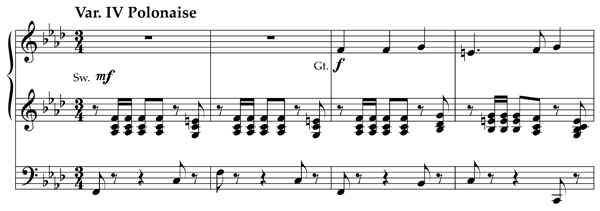After celebrating Independence Day last week, today is France’s national holiday: Bastille Day! While I couldn’t find the recording of Pierre Cochereau’s improvisation on La Marseillaise for General de Gaulle’s funeral on line, I did find Jeremy Filsell’s transcription/recreation for your listening pleasure:
While the theme is normally in a major key, as this improvisation was originally created for a funeral, the minor mode beginning suits the occasion perfectly. When we began creating holiday variations last week, we started working with Charles Ives’ Variations on ‘America’. Ives also provides us with a variation in minor which is what we will focus on today. (Here’s a link to the video in case you want a refresher.)
Polonaise
The polonaise (which is the French word for ‘Polish’) is a traditional Polish dance in 3/4 time. Ives includes one of these dance movements as his fourth variation on America. You can see the traditional rhythm in the excerpt below:

As mentioned last week, rarely does Ives let a measure go by without any thematic material. Here we have two measures to practice our polonaise rhythm before beginning the theme. If we wish to improvise polonaises, we could spend much more than two measures practicing the rhythm. Choose some simple chord progressions and practice the rhythm in different keys. While Ives keeps the rhythmic figure confined to the left hand and pedal, we could also practice it with right hand and pedal or hands alone.
Once you have mastered the rhythm, then it’s time to add in the theme. For the first half of this variation, the theme is played by the right hand on a solo stop. If necessary, practice soloing out the theme with a simplified accompaniment first before adding the polonaise rhythm back in. For the second half, Ives requires the left hand to play both the theme and the rhythm. Just as you would probably want to practice the left hand alone if you were learning the Ives, so too, you probably want to practice the same idea with whatever theme you have chosen to turn into a polonaise. The first variation in the Ives set has the left hand playing the harmonized theme, so even Ives gives you a simplified version to practice first before increasing the difficulty level. The right hand then adds some sparkle with it’s commentary.
Fireworks
It is interesting to contrast the Polonaise with the first variation Ives offers. Having already practiced the harmonized theme played by the left hand and pedal in a simplified rhythm, rather than add difficulty to the left hand, Ives adds a running line for the right hand to play. He begins with sixteenth notes (basically four notes to each note of the theme), but then doubles the speed to 32nd notes (8 to 1)! The fast motion, large leaps upward and chromatic movement downward make me think of fireworks which seems a most fitting idea for variations on a patriotic song.
While these two variations appear to be very different, there are several common techniques that we can practice to advance our improvisation skills. Thanks to registration options at the organ, we could also practice the same ideas found in each of these variations but swapping hands. For example, use right hand and pedal to play the polonaise rhythm while the theme is played by the left hand in either the tenor or soprano register. Play the theme with right hand and pedal while the left hand adds fireworks on a 2′ stop! What if the polonaise was in a major key and the fireworks in minor? What other dance rhythms could you use instead of a polonaise?
While not looking to start a revolution today, I hope you are inspired to create your own fireworks while practicing your improvisations!
Viva la France!
Glenn
Recent additions to organimprovisation.com:
Organists:
Review and Competition:
- Jan Overduin – Making Music: Improvisation for Organists
- St. Alban’s International Organ Competition
Themes:
Newsletter Issue 12 – 2014 07 14
See the complete list of past newsletter issues here.
Sign up to receive future issues using the box to the right on this page.
